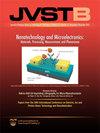在Si衬底上选择性生长的Ge条带结构的硅帽诱导表面粗化
IF 1.4
4区 工程技术
引用次数: 2
摘要
本文报道了通过超高真空化学气相沉积在Si上选择性生长出条带状Ge结构,并伴有Si- Ge合金化。在暴露于sio2掩膜Si衬底中的Si(001)表面上,选择性地生长出沿[110]方向的0.7 μm宽的Ge条状结构和100 μm宽的台面结构。与Ge厚度为0.5 μm的由顶部(001)面和侧壁{113}面组成的宽台面结构相比,窄条形结构的顶部(001)面几乎消失。带材主要由靠近顶部的倾斜{113}面和靠近侧面的{111}面包围,而靠近底部边缘的结构取决于生长温度(600/700℃)。随后在600°C下生长厚度为10nm或更大的Si帽层,以保护脆弱的Ge表面。扫描电镜观察显示{113}面表面粗糙,在{111}面边界附近有凹陷。拉曼光谱分析表明,由于Si-Ge的相互扩散作用,在带材和宽台面侧壁上形成了SiGe合金。在宽台面顶部的(001)平面上没有这种SiGe合金。具有错配应变的Si帽层可能作为下垫Ge的应力源,施加集中在面边界周围的应力,并在Si - Ge相互扩散的过程中引起质量传递,从而导致应变松弛。在实际器件的制造中,将Si帽层的生长温度从600℃降低到530℃是抑制粗化和合金化的重要措施。本文章由计算机程序翻译,如有差异,请以英文原文为准。
Si-capping-induced surface roughening on the strip structures of Ge selectively grown on an Si substrate
Si-capping-induced surface roughening, accompanying Si–Ge alloying, is reported for strip structures of Ge selectively grown on Si via ultrahigh vacuum chemical vapor deposition. A 0.7-μm-wide strip structure of Ge running in the [110] direction, as well as a 100-μm-wide mesa structure, is selectively grown on an Si (001) surface exposed in an SiO2-masked Si substrate. In contrast to a wide mesa structure with a Ge thickness of 0.5 μm, composed of a (001) plane at the top and {113} facet planes at the sidewalls, the (001) top plane almost disappears for the narrow strip structure. The strip is mainly surrounded with inclined {113} planes near the top and adjacent {111} planes at the side, while the structure near the bottom edges depends on the growth temperature (600/700 °C). An Si cap layer with a thickness of 10 nm or larger is subsequently grown at 600 °C to protect the fragile Ge surface. The scanning electron microscopy observations reveal a roughened surface on the {113} planes, with depressions specifically induced near the boundary with the {111} planes. The Raman spectra indicate that an SiGe alloy is formed on the strip and the wide mesa sidewalls due to the Si–Ge interdiffusion. There is no such SiGe alloy on the (001) plane of the wide mesa top. The Si cap layer with a misfit strain probably works as a stressor for the underlying Ge, applying stress concentrated around the facet boundaries and inducing a mass transport alongside the Si–Ge interdiffusion for strain relaxation. In terms of the fabrication of practical devices, it is important to suppress the roughening and alloying significantly by decreasing the growth temperature for the Si cap layer from 600 to 530 °C.
求助全文
通过发布文献求助,成功后即可免费获取论文全文。
去求助
来源期刊

Journal of Vacuum Science & Technology B
工程技术-工程:电子与电气
自引率
14.30%
发文量
0
审稿时长
2.5 months
期刊介绍:
Journal of Vacuum Science & Technology B emphasizes processing, measurement and phenomena associated with micrometer and nanometer structures and devices. Processing may include vacuum processing, plasma processing and microlithography among others, while measurement refers to a wide range of materials and device characterization methods for understanding the physics and chemistry of submicron and nanometer structures and devices.
 求助内容:
求助内容: 应助结果提醒方式:
应助结果提醒方式:


